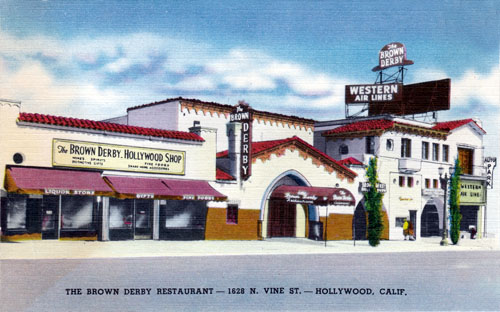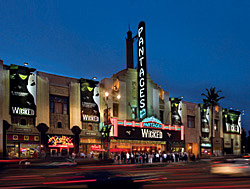This important building complex in Los Angeles' telecommunications history began life in 1907 when the Home Telephone company built a telephone and telegraph switching office to handle 10,000 lines for the city. The first of the existing buildings was built in 1925 (facing Olive Street) to handle switching functions for the 213 area code. Subsequent buildings were added to the complex in 1945 and 1961, which is the 17-story structure with the iconic microwave tower which functioned in the 1960s-1990s to handle important signal transmissions. Today, the complex, which also handles state-of-the-art fiber optic cable transmssions and data co-location, is one of the largest telecommunications central offices in the US, and handles over 1.3 million phone lines for local, national and long-distance calls. Do note the public art sculpture on Grand Ave comprised of old telephone equipment.
427 W. 5th St, Downtown
Built in 1906 as the Temple Auditorium, it was a mixed-use theatre/Baptist church designed by Charles F. Whittlesey, at the time the largest theatre building west of Chicago. It was also known as Clune's Theatre. In 1920 the Los Angeles Philharmonic Orchestra moved in for its second season (thereby renaming the building "
"), where it remained until the opening of the Dorothy Chandler Pavilion in 1964. It was demolished in 1985 where it became a surface parking lot until recently, where it is currently being developed as the Park Fifth mixed-use project.
624 S. Grand Ave, Downtown
Built during the first wave of modern skyscrapers following the repeal of Los Angeles' building height limit laws, this building, designed by architectural rockstars
(who also went on to craft Chicago's Sears Tower, among many others) stood for most of its life as the address of legal and financial institutions. After a renovation in 1992, this building is now the location of
, a major data colocation center, which carries the primary Internet connections for Los Angeles (without this building,
Take note of the row of palm trees, planted here in the 1970s: They are meant to evoke the end of Wilshire Boulevard, as on the opposite end, at Santa Monica's Ocean Avenue, 16 miles from here, you will also find a row of palm trees.
designed by Harry C. Deckbar was the first home of the Los Angeles Philharmonic Orchestra during its debut season in 1919. The building originally functioned as a mixed-use Methodist Episcopal church and hotel complex and was once owned by USC during the 1980s-1990s. It is currently being renovated into a hotel again.
7. L.A. Prime Matter Sculpture
1991
Wilshire and Figueroa (NW corner), Downtown
Wilshire is full of awesome-looking public art. Here's one relatively-recent sculpture,
recently renovated, right at the northwest corner of Wilshire and Figueroa. Designed by the late Venice-based artist
Eric Orr, who had a penchant for utilizing elemental themes in his art,
L.A. Prime Matter features twin 32-foot bronze columns that feature water sliding down its faces, and during random moments, FIRE emanates from the middle channels of the columns every hour on the hour! The effect is total bad-ass, and its bad-assnes is magnified at night.
8. Wilshire Grand Center
2017
900 Wilshire Blvd, Downtown
On this site rises the new
Wilshire Grand Center, Los Angeles' (and the West's -- suck on it,
Transbay Tower SF!) tallest building at 73 stories and 1,100 feet (kinda sorta, there's a spire, you see...). Opened on June 23, it is the city's only modern skyscraper without a flat roof, the only Los Angeles building since Hollywood's Capitol Records tower in 1956 to feature a spire, the first skyscraper anywhere to sport a mohawk, and it also has its own irreverent
Twitter account. ;)
Owned by Korean Air (hence the red and blue
taeguk LED logo), the tower houses the 900-room
Hotel Intercontinentalwith its 70th-floor Sky Lobby and the unique Spire 73 skybar, with wonderful views of the south and west (the sunset vista from here is not to be missed).
The building's construction site was the location of "The Big Pour" - which lasted from February 15 -16, 2014, where 21,200 cubic yards (81 million pounds) of concrete for the tower's foundation were continuously poured - earning it
a Guinness World Record for that feat.
Before the skyscaper, the site was home of the Wilshire Grand Hotel, formerly (in reverse chronological order) the Omni Hotel, Los Angeles Hilton, Statler Hilton and Statler Hotel.
9. Site of George Shatto Residence/Good Samaritan Hospital
1891
Wilshire Blvd and Lucas Ave, Downtown
Before it was named Wilshire Boulevard, it was once called Orange Street, and on the corner of Orange and Lucas was a Queen Anne-style mansion belonging to George Shatto, a real estate developer who first developed Catalina Island and the city of Avalon. If you read the
Epic CicLAvia Tour 4.0 post, his name is brought up as one of the famous Angelenos buried (in a rather ornate pyramid) at Angelus Rosedale Cemetery.
But check this out! Take a look at the picture above, and pay close attention to the masonry wall going uphill that fronts Lucas Avenue. Now, on CicLAvia Sunday, look at the exact same spot, on the northwest corner of the intersection. The house is gone, but the original wall
still remains!
Good Samaritan Hospital, which was founded in 1885 and moved to the current site in 1911, is also the birthplace of many native Angelenos, including mayor
Eric Garcetti.
10. S. Charles Lee Office and Residence
1903/1935
1648 Wilshire Blvd, Westlake.
Architect S. Charles Lee was famous for designing some of Los Angeles' ornate theaters along Broadway, including the
Los Angeles Theatre and the
Tower Theatre (a.k.a.
The Apple Mac Tower Pro Theatre). He moved his family to a two-story Victorian house on Wilshire and in 1935 built his Regency Moderne-style office right in front of it,
a unique live-work space arrangement of its time.
11. Los Angeles Teachers (a.k.a. 'Stand And Deliver') Mural
1997
Wilshire and Alvarado, Westlake
Art imitates life imitating art imitating life in
this mural by popular Salvadoreño American muralist
Hector Ponce depicting actor Edward James Olmos, who portrayed Garfield High School math teacher Jaime Escalante in the 1988 movie
Stand and Deliver, standing next to the real-life Escalante, and delivering a mural that's part-Hollywood, part-Los Angeles, part-Latino pride, part Eastside pride and if the Internet were as accessible back in 1988 as it is today, would make one epic photo meme. And it's painted behind the 1926
Westlake Theatre, which is slated for renovation into a community-based performance arts venue sometime soon.
12. Gen. Harrison Gray Otis Statue
1920
Wilshire Blvd and Park View Ave, Westlake
Gen. Otis is perhaps the most visible statue at the park, which predates MacArthur's WWII service. This general served in the Spanish-American and Philippine-American wars, and also fought as a Union soldier in the Civil War. But in Los Angeles, he is most known for being the founder, owner and publisher of the Los Angeles Times. So why is he here? His Wilshire Blvd mansion, called The Bivouac, was located across the street, was later donated to Los Angeles County and became the original campus of
Otis Art Institute. It's thought that his statue is pointing to the site of the Elks Lodge, but he's probably just pointing to his old house. BTW, Gen. Otis was the grandfather of Dorothy Chandler's husband, Norman.
13. Bryson Apartment Building
1913
2701 Wilshire Blvd, Westlake
This 10-story Beaux Arts apartment building, built 100 years ago, was the 20th century precursor to today's fancy modern 21-century high-rise residential developments. Built by developer Hugh W. Bryson and designed by Noonan & Kysor, it was built in a part of Los Angeles that was known at the time as "the west side" (let's not open that can of worms right now, okay?). It was one of Los Angeles' most luxurious apartment buildings, and had a large neon sign at the roof (characteristic of these kinds of developments back then). Several Raymond Chandler books reference The Bryson. The 110,000 square-foot building is also part of the National Register of Historic Places and a Los Angeles Historic-Cultural Monument.
14. Lafayette Park
1899
Wilshire Blvd and LaFayette Park Place, Westlake
Clara Shatto, the widow of 19th-century real estate developer George Shatto donated 35 acres of her land to the City of Los Angeles in 1899, which was once oil wells and tar pits. Her late husband wanted it turned into a city park, and so it became Sunset Park, which existed for 19 years before the locals wanted it renamed to honor the 18th-century Frenchman who was a hero in both the American and French revolutions. Gotta give LaFayette park some props for living so long in the shadow of its more famous neighbor, MacArthur (Westlake) Park.
15. Bullocks Wilshire/Southwestern Law School
1929
3050 Wilshire Blvd
Perhaps one of the most iconic examples of Art-Deco architecture in Los Angeles, this former Bullocks Department Store was designed with a tower to resemble a New York-style skyscraper in then-unabashedly low-rise Los Angeles. It was the epitome of shopping in style in its heyday, with its own rear parking lot and other auto-centric amenities. It ultimately fell victim to the 1992 Los Angeles Riots and was closed down the next year. In 1994, the nearby
Southwestern School of Law bought the building and incorporated it into its campus, restoring much of the Roaring 1920s Art Deco aesthetics.
16. Consulate Row
Various locations along Wilshire Blvd between Vermont and Crenshaw
Some 62 countries have consular offices in the Los Angeles area and 41 of them have addresses on Wilshire Boulevard. Proximity to various foreign financial institutions on Wilshire, as well as nearby Hancock Park, where many consul-generals have traditionally resided, are the main reasons for such a high concentration of consulates on this stretch of Wilshire. The consulate offices for Bangladesh, Bolivia, El Salvador, Ethiopia, Guatemala, Honduras, Indonesia, South Korea, Nicaragua, Peru, The Philippines, Sri Lanka and Taiwan are all located on Wilshire between Vermont and Crenshaw. Many of them display their national flags in front of their respective office buildings. How many can you spot during CicLAvia?
17. Gaylord Apartments
1924
3355 Wilshire Blvd
Though the building's prominent neon sign has been source of many a snicker by immature junior high school kids, this building represents some serious history. It was named after Wilshire Boulevard's namesake, Henry Gaylord Wilshire, who was known as a wealthy real estate developer and outspoken socialist (Does that make sense?), who donated a 35-acre strip of barley fields to the City of Los Angeles on the condition that it would be free from railroads or trucking.
The building itself is a 13-story Italian Renaissance-style apartment building that actor John Barrymore (a.k.a. Drew's grandpa) and then-presidential candidate Richard Nixon once called home.
18. Wilshire Brown Derby Site
1926
3427 and 3377 Wilshire Blvd
The now-defunct "The Brown Derby" local chain of restaurants were synonymous with Hollywood glitz and glamour. The Wilshire Boulevard location was the first of four (the others were in Hollywood, Beverly Hills and Los Feliz). In close proximity to The Ambassador Hotel and its Cocoanut Grove swing/jazz club, this was the original hipster joint back in the day, only back then the hipsters were actually cool and looked good. In 1937 the building was moved across the street and closed in 1975. In 1980, a shopping center was built on the site and the iconic dome structure was incorporated into the shopping center that exists today. It's situated on the third floor, above The Boiling Crab seafood restaurant. It's something to ponder on while you wait 90 minutes for your table.
Note that the pictures for #17 and #18 connect vertically - that's the Gaylord Apartments behind the Brown Derby!
19. Robert F. Kennedy Inspiration Park/Ambassador Hotel Site
2010
Wilshire Blvd between Catalina Street and Mariposa Avenue
The Militant
wrote a post in 2010 about this unique public space dedicated to Sen. Robert F. Kennedy, who was assassinated just yards away at the Ambassador Hotel, which was demolished in 2005 and where the LAUSD's sprawling and costly RFK Community Schools campus now stands. There's Kennedy quotes on public art installations and benches for you to chill on. There's also speakers playing recordings of some of the jazz music that was performed at the hotel's famed Cocoanut Grove swing and jazz club.
20. Wiltern Theatre/Pellissier Building
1931
Wilshire Blvd and Western Avenue (duh...), Koreatown
The 12-story structure, designed by Stiles O. Clements, is Los Angeles' emerald-green temple to all that is Art Deco. Originally operating as the "Warner Theatre" (Specifically the Western Avenue location of Warner Bros. chain of movie theaters; The Warner Theatre in San Pedro is another example), The Wiltern (named so since 1935) has seen many cycles of decay and rebirth, most recently in the 1980s, when preservationists renovated the theatre to a performing arts venue. The contemporary Wiltern Theatre has been operating since 1985.
21. MaDang Courtyard Mall
2010
621 S. Western Ave, Koreatown
The heart of K-town is essentially the revived district once known as Wilshire Center, a mid-rise commercial district which emerged in the mid-1960s, filling in the commercial real estate gap between Downtown and Miracle Mile. By the late 1980s, the district had fallen into disarray, with many businesses closing down or moving out, culminating around the time of the 1992 Riots (the iconic Bullocks Wilshire closed down in 1993). With the old guard having moved out, it allowed opportunities for the then-scattered Korean business community, fueled by an abundant supply of investment money from South Korea, to move into the vacant retail and office spaces and expand Koreatown into the large district that exists today. Enter MaDang Courtyard, which opened in 2010. This dense, triple-story urban mall represents not only the modern Koreatown, but a more of a visual semblance of Seoul, as opposed to the re-purposed commercial spaces of the old Wilshire Center. Anchored by the
CGV Cinemasmultiplex, which screens current Hollywood features, Korean films and Korean-subtitled versions of mainstream blockbusters, you can't get more K-town than that (for a non-food establishment). But speaking of food establishment, there's also a
Hansol Noodle location here, a
Paris Baguette (despite the francophone name, it's a South Korean bakery cafe chain), a
Lemon Tree kids' play cafe and Japanese imports
Daiso (picture a Nippon version of the 99 Cents Only store) and pastry chain
Beard Papa's. It's like a trip across the Pacific (minus the jet-lag).
AND NOW, A BREAK AT THE HALFWAY MARK...
The CicLAvia route visits Western Avenue for the very first time. But this isn't the first car-free, open street event that's popular with cyclists. In fact, they've been doing it 122 years ago...
This photo, taken in 1896, shows a group bicycle ride up an unpaved Western Avenue (back then called County Road), back in the agricultural days. What comes around, goes around!
22. Selig Building
1931
269 S. Western Ave, Koreatown
This single-story black and gold terra cotta Art Deco storefront building (like total
LAFC style, yo!) designed by Arthur Harvey was originally the Alvin C. Selig men's formalware store when it opened in the 1930s and later became a Crocker National Bank branch and video store. Today, the newly-renovated building is subdivided into separate retail spaces, which includes
The Dolly Llama Waffle Master restaurant.
23. St. Charles Apartments Wall Advertisements
1925
240 S. Western Ave, Koreatown
Several generations of painted wall advertisements can be seen on the southern-facing wall of the 1925 St. Charles apartment building, including a faded 1920s-era Sparkletts Water ad, a 1970s Coca-Cola ad and a more contemporary ad for a Korean lighting fixture store.
 24. US Post Office - Nat King Cole Station
24. US Post Office - Nat King Cole Station
1987 (Dedicated 2002)
265 S. Western Ave, Koreatown.
Formerly the United States Postal Service's Oakwood Station, it was dedicated to singer Nat King Cole in 2002, who lived nearby on Murfield Rd. and 4th Street in Hancock Park from 1948 to his death in 1965. The facility is slated to move to a new location nearby as the current building will be demolished for redevelopment.
25. Original Home of See's Candies
1921
135 N. Western Ave., Koreatown
Canadian immigrant Charles See, along with his wife Florence, their children and his mother Mary, moved to Los Angeles where they opened a candy shop at this location in November, 1921 using Mary's recipes from when she helped run her late husband's hotel in southern Ontario. The operation soon blossomed into multiple stores, even booming during the Great Depression, and can be found in 17 states. The candies are made here in California, at its factories on La Cienega Blvd and in South San Francisco. The original See's Candies location is currently a
Tom N Tom's (a.k.a. Korean Starbucks) coffee shop.
26. Postmodern KFC
1990
340 N Western Ave., Koreatown.
Designed by Elyse Grinstein and Jeffrey Daniels (both who previously worked for Frank Gehry's architectural firm), the two-story building is a postmodern representation of not just a bucket of chicken, but a chicken itself. It is also one of the few KFC franchises to still bear the full "Kentucky Fried Chicken" name signage.
27. Janss Investment Co. Uptown Branch Bldg.
1928
500 N. Western Ave., Koreatown
This unique Byzantine domed building was designed by Percy Parke Lewis (can't lose?), who also designed the Art Deco Village Theatre in Westwood, was built as the Janss Investment Company's Uptown Branch office (this was once "Uptown"? Well Uptown Funk gonna give it to ya). Today it's repurposed as the Korea Sah Buddhist temple.
28. Hollywood Melrose Hotel
1927
5162 Melrose Ave, Hollywood.
This three-story building was designed by S. Charles Lee (remember him?) and opened in 1927 as the Hollywood Melrose Hotel. It later became rental units known as the Melrose Arms and Monte Cristo Island Apartments. In 1992 it made the National Register of Historic Places and was returned to an inn in 2010, re-branded as the Hollywood Historic Hotel which is now run by the Armenian family that owns the Edmon’s Unique Furniture and Stone Gallery business on the ground floor.
1923
5152 La Vista Ct, Hollywood.
This
may or may not be the former residence of famous writer Jack London,
who has a bas-relief memorial sculpture on the outside wall of this unique, quirky 3-story
residence in an alley named La Vista Court. Actually no, it was built seven years after London's death,
but it was designed by London's friend, sculptor Finn Hakkon Frolich.
This well-researched blog post details the history and mythology of the house that writer Jack London may or may not have lived in.
30. Raleigh Studios
1914
5300 Melrose Ave, Hollywood
Standing in the shadow of
its much more famous neighbor across the street,
this independent motion picture facility was founded in 1914 as the Fiction Players company studios, and later on as Clune Studios (Yes, the same William H. Clune that owned what later became Philharmonic Auditorium) in 1915. This studio facility was later associated with stars like Douglas Fairbanks and Charlie Chaplin. It was the filming location of classic TV shows like "The Adventures of Superman" and "Gunsmoke" (1950s); "Dallas," and Madonna's "Like A Prayer" music video (1980s) and Nirvana's "Heart-Shaped Box" video (1990s).
31. Happy Days House
1923
565 N. Cahuenga Blvd, Hancock Park.
"Aaaaaayyyyyyy!!!" This Colonial-style house on 565 N. Cahuenga Blvd stood in for the Cunningham Residence in the hit ABC TV series, "Happy Days" from 1974 to 1984, where it was "565 Clinton Drive" in Milwaukee, Wisconsin (Interesting, since Clinton Street is the closest intersection). Though mostly used in establishing shots, the actual sitcom was filmed a half mile to the east at Paramount Studios.
 32. Arroyo de los Jardines
32. Arroyo de los JardinesWest of Rossmore Avenue, north of Beverly Boulevard, Hancock Park
One of few remaining exposed active creeks in the Ballona Watershed, this "Creek of the Gardens," as it is named in Spanish runs through the center of the Wilshire Country Club's golf course. The Hollywood area was full of various creeks that ran southward from the Hollywood Hills in the days before urbanization, which led to the area being an attractive place for agriculture. South of Beverly, the creek goes underground and surfaces again in various places before ending up at Ballona Creek, where its flow washes out to the Pacific Ocean in Marina Del Rey. The Militant
talked more about this creek in a 2008 blog post.
1929
450 N. Rossmore Ave, Hancock Park
This Spanish/French/Roccoco Renaissance luxury apartment building in Hancock Park, built during the Depression era for $1.25 million, was designed by Douglass Lee (also the architect of Chateau Marmont in West Hollywood), has been home to many a celebrity since, including
Clark Gable and Loretta Young, as well are more contemporary stars like Uma Thurman, Ben Stiller and Cameron Diaz. It was also Huell Howser's urban residence (when he wasn't hanging out in his desert volcano home) from 1980 to 2012.
34. Site of Gold Star Recording Studios
1950-1984
6252 Santa Monica Blvd, Hollywood
Since this CicLAvia is focused on music with various musical performances along the route, this site was home of Gold Star Recording Studios, which lasted from the 1950s to the early 1980s. In the 1960s, it was most associated with (pre-murderer era) producer Phil Spector, who recorded The Beach Boys' hit "Good Vibrations" here, as well as parts of their legendary
Pet Sounds album. The studio was used by countless artists such as Ritchie Valens, Herb Alpert, Sonny and Cher, The Monkees, The Go-Gos, The Chipmunks, John Lennon, The Who and Jimi Hendrix. The Militant
covered this spot back in 2008.
35. Wild Card Boxing Gym
1995
1123 N. Vine St, Hollywood
Founded and still operated by legendary boxing trainer Freddie Roach, this facility has been the choice training spot for amateur and professional boxers for the past two decades. Boxers such as Mike Tyson, Oscar De La Hoya, Manny Pacquiao, Miguel Cotto and Julio Cesar Chavez, among many, have trained in this 2nd-floor gym perched above a nondescript minimall. And oh yeah, this places smells like nasty-ass humid BO. The Militant
was here back in 2007.
36. Site of Hollywood Ranch Market
1929-1981
1240 Vine St, Hollywood
Opened as the Mandarin Market in 1929 (pre-dating
its more famous and celebrated cousin down at 3rd and Fairfax), the
Hollywood Ranch Market was one of Hollywood's biggest retail attractions, featuring a 24-hour (yes, Hollywood had late night establishments even back then) indoor marketplace (the large neon sign featured the words, "We Never Close") selling fresh produce, groceries, and offering services such as check cashing and shoe shining. It was also featured in many movies and television shows back in the day. Unfortunately, the market burned down in a fire in 1981 and was replaced with the Office Depot-anchored shopping center that stands today.
37. Pickford Center/Mutual-Don Lee Studios
1948
1313 N. Vine St, Hollywood
Functioning today as the
Academy of Motion Picture Arts and Science's Pickford Center for Motion Picture Study, this is the oldest building in Hollywood built for television production. It opened in
1948 as the headquarters of the old Mutual-Don Lee (that's Lee as in Mt. Lee, home of the Hollywood Sign) broadcast network, which birthed an early TV station, KTSL (for Thomas S. Lee, Don's son). In 1950, CBS took over the operation and years later it was the home of KHJ (now KCAL) Channel 9. In 1964, public TV station KCET
began broadcasting here until it moved 3 1/2 miles east to Los Feliz in 1970. ABC took over the facility until the 1990s, when AIDS Project L.A. located its offices at the former studio. The Academy has used the old Don Lee studios since 2002.
38. Site of NBC Studios
1938-1962
1500 N. Vine St, Hollywood
Before The Peacock Network was associated with "
Beautiful Downtown Burbank," it called the northeast corner of Sunset Boulevard and Vine Street its (West Coast) home.
It began life as Radio City West (after NYC's Radio City), and the broadcast facility became influential in the industry, prompting rivals ABC and CBS to locate their western headquarters in close proximity. Local affiliate KNBC channel 4 was born here in 1949 (then known as KNBH, later becoming KRCA in 1954). It took on the KNBC call sign when the operation moved out to The 'Burb[ank] in 1962. The iconic Streamline Moderne studio building was torn down and replaced with a Home Savings and Loan bank branch (now operating today as Chase Bank). The Sunset & Vine retail/residential complex across the street gave an architectural nod to the NBC building with Streamline Moderne touches).
39. Hollywood Brown Derby Site/Metro Bike Hub
1929-1985/2017
1628 N. Vine St, Hollywood
Did you know that
Metro's
Hollywood Bike Hub facility, which opened last year, stands on the very site of the Hollywood Brown Derby restaurant? This was the second location of
the legendary local restaurant chain.(See Point #18) Back in the Hollywood Heyday of the first half of the 20th century, it was like
the lunch and dining hotspot for famous film stars and industry moguls. But perhaps the biggest star associated with the Hollywood Brown Derby was the
Cobb Salad, invented here circa 1937. Named after Brown Derby co-owner Robert Cobb, it was an improvised mish-mash of leftover salad ingredients, either made for theater mogul Sid Graumann or by Cobb himself as a late-night meal (depending on which version of the legend). The restaurant closed down in 1985 and the iconic Mediterranean-style structure was burned in a fire two years later. It was finally demolished in the mid-1990s after the Northridge Earthquake.
40. Hollywood Pantages Theatre
1930
6233 Hollywood Blvd, Hollywood
Opened in 1930, this was actually the second theatre in Los Angeles bearing the Pantages name (
the first one, still standing on 7th and Hill streets, opened a decade earlier and was renamed the Warner Theatre in 1929). This was also the last theatre built bearing the name of vaudeville promoter Alexander Pantages, who ran a chain of 84 theaters across North America back in the day. The iconic Art Deco venue designed by B. Marcus Priteca (who also drew up the DTLA Pantages, as well as other theaters) actually functioned as a cinema for most of its history until 1977 when it ran the Broadway musical
Bubbling Brown Sugar and the rest is Jazz Hands history. But did you know that the building constructed nearly 90 years ago is actually incomplete? It was originally supposed to stand 12 stories tall with offices.
There have been recent proposals to complete the structure.
41. Hollywood and Vine
1887
Hollywood Blvd and Vine St (duh), Hollywood
Originally part of Hollywood pioneers Horace and Ida Wilcox's ranch (Ida was the one who dubbed the former Cahuenga Valley (named after the Tongva village known as Cahug-na) the name "Hollywood"), two dirt roads were cut through it: the east-west Prospect Avenue and Weyse Avenue running north-south. In 1903, a Methodist church was built on the southeast corner, soon followed by a number of businesses. When Hollywood was annexed to Los Angeles in 1910, Prospect and Weyse went all showbiz by changing its name to Hollywood Boulevard and Vine Street and a decade later, the corner became world famous due to being a hub of radio and movie-related businesses.
The Pacific Electric Railway's Western and Franlin Ave. Line even terminated here during that period from 1908 to 1940. Today it is
arguably the World's Most Famous Intersection (seriously, try to name a more famous corner), and in July of 2018,
a diagonal "scramble" pedestrian intersection was installed by the City.
42. Capitol Records Building/Hollywood Jazz Mural
1956/1990
1750 N. Vine St, Hollywood
You may or may not already know that the Capitol Records building is: a) The world's first circular office building (designed by Louis Naidorf of Welton Becket associates -- the same architectural firm that designed the Dorothy Chandler Pavilion (Point #1), at the opposite end of the CicLAvia tour (How's
that for full circle [pumps fist]?)); b) Designed like a stack of records; and c) The FAA warning light atop its spire spells "HOLLYWOOD" in Morse Code. What you probably didn't know was that Capitol Records, founded in 1942, was the first major record label headquartered in the West Coast, and that the building was largely financed by the profits made from its premier artist at the time, Nat King Cole (See Point #24). Also, to make yet another connection to another point on this CicLAvia tour, this is one of two skyscrapers in Los Angeles with a spire, the second being the Wilshire Grand Center (Point #8). Dude, is everything like interconnected
or what?! And speaking of Nat King Cole, Capitol's classic crooner is depicted front and center in the 88 foot-wide mural facing the building's south parking lot, "Hollywood Jazz, 1948-1972" by African American muralist (and Lynwood native)
Richard Wyatt, Jr. painted in 1990 and restored in 2011.


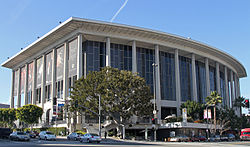



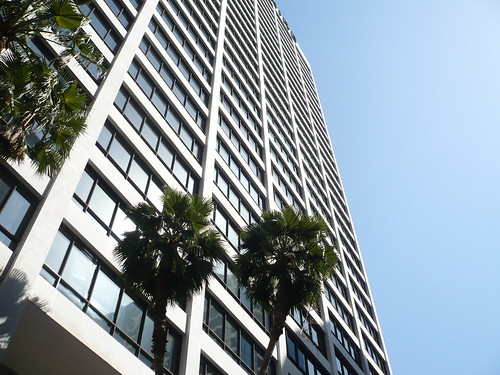





















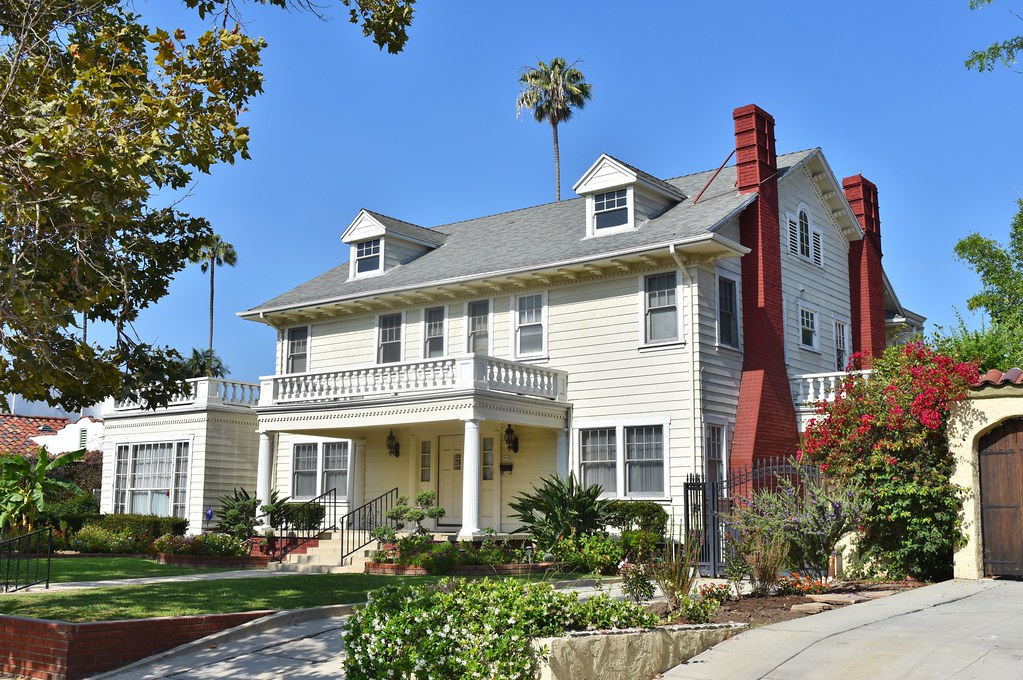

:format(webp):no_upscale()/cdn.vox-cdn.com/uploads/chorus_asset/file/16362564/gyQ4CEbU.jpeg)



